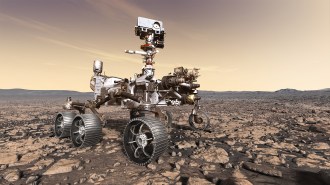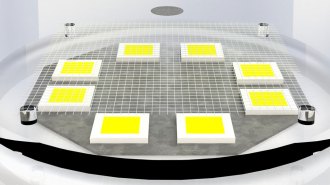Uncategorized
-
 Planetary Science
Planetary ScienceNASA’s Perseverance rover has touched down on Mars
The spacecraft will arrive at Mars on February 18, joining missions from China and the United Arab Emirates.
-
 Animals
AnimalsA rare bird sighting doesn’t lead to seeing more kinds of rare birds
The idea that more kinds of rare birds are seen when birders flock to where one has been seen, the so-called Patagonia Picnic Table Effect, is a myth.
-
 Anthropology
AnthropologyA body burned inside a hut 20,000 years ago signaled shifting views of death
Ancient hunter-gatherers burned a hut in which they had placed a dead woman, suggesting a change in how death was viewed.
By Bruce Bower -
 Plants
PlantsModified genes can distort wild cotton’s interactions with insects
In a Yucatan nature park, engineered genes influence nectar production, affecting ants’ and maybe pollinators’ attraction to the wild cotton plants.
-
 Psychology
PsychologyIn the social distancing era, boredom may pose a public health threat
Boredom contributes to pandemic fatigue and may account for why some people don’t follow social distancing rules.
By Sujata Gupta -
 Health & Medicine
Health & MedicinePfizer’s vaccine appears to reduce coronavirus transmission
People who carry low amounts of the coronavirus in their bodies are less likely to spread COVID-19. Pfizer’s shot appears to help reduce viral loads.
-
 Physics
PhysicsTiny, sunlight-powered aircraft could soar beyond airplanes’ reach
Microfliers levitate when hit with light, in conditions like those high in Earth’s atmosphere.
-
 Health & Medicine
Health & MedicineMaking masks fit better can reduce coronavirus exposure by 96 percent
Double masking, rubber bands and other hacks can produce a tighter fit and prevent aerosol particles that can carry coronavirus from getting through.
-
 Physics
Physics50 years ago, scientists were on a quest for quarks
In the 1970s, physicists confirmed particles called quarks existed. Fifty years later, many kinds of quarks in many combinations have been discovered.
-
 Astronomy
AstronomyThe number of Milky Way nova explosions per year has been pinned down
Knowing how frequently these stellar eruptions occur will help determine their contribution to the galaxy’s chemical makeup.
By Ken Croswell -
 Archaeology
ArchaeologyStonehenge may have had roots in a Welsh stone circle
Ancient migrants to southern England brought the makings of the iconic monument with them, researchers suspect.
By Bruce Bower -
 Science & Society
Science & SocietyBlack, Hispanic and female police use force less often than white male officers
A case study of Chicago policing suggests that diversifying to include more Black, Hispanic and female officers may improve how civilians are treated.